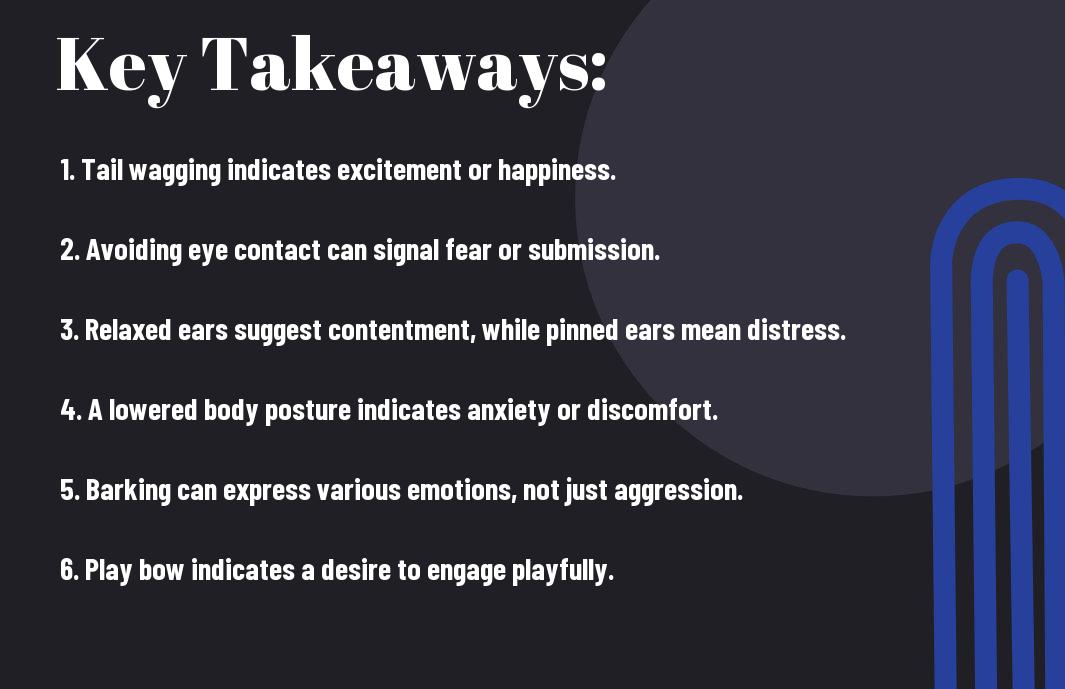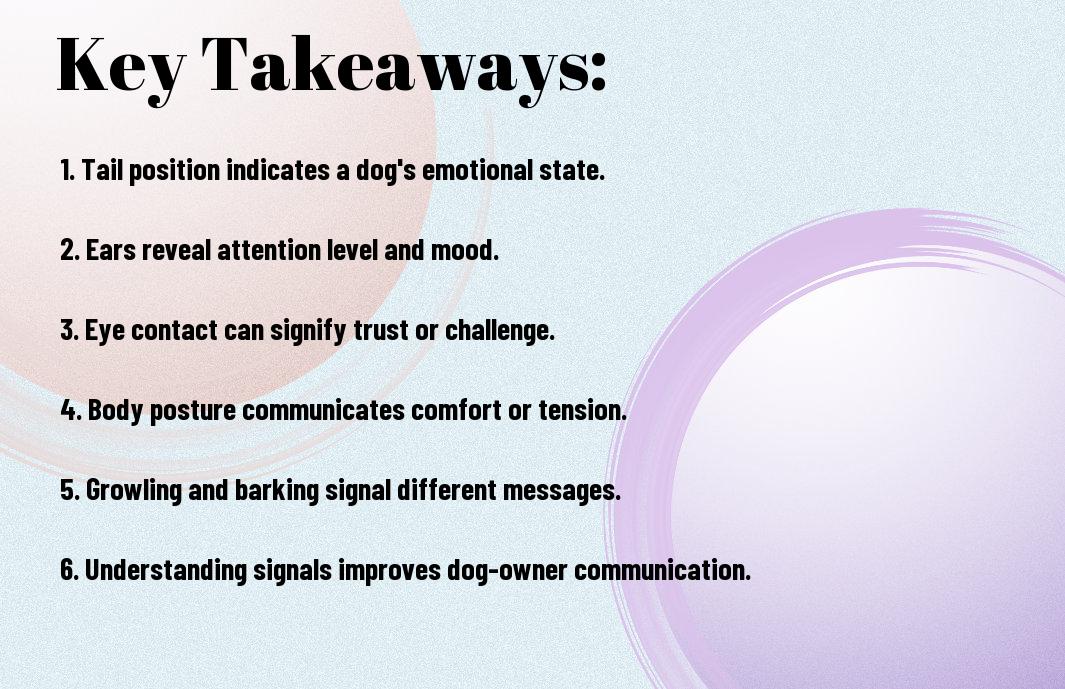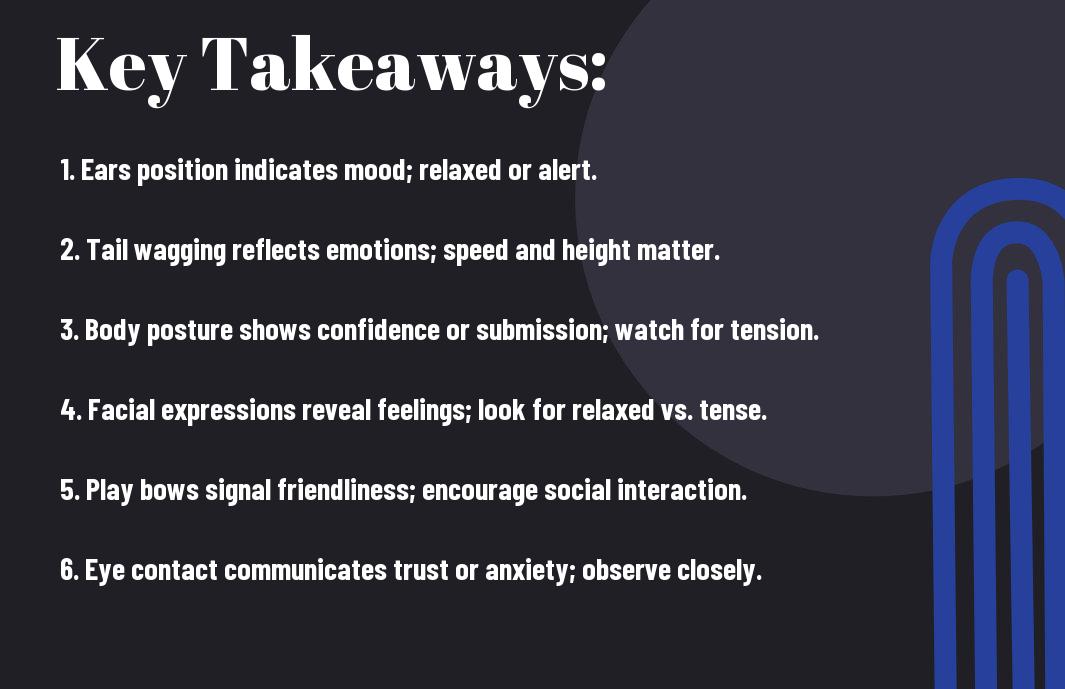There’s a wealth of insight to gain from observing your dog’s body language and behavior. By learning to interpret the signals your furry friend is sending, you can enhance your bond and ensure their well-being. Recognizing signs of stress or fear can help you intervene before situations escalate, while understanding signs of happiness and contentment allows you to nurture their positive experiences. This blog post will guide you through the crucial aspects of your dog’s non-verbal communication, empowering you to respond appropriately to their needs.


The Importance of Canine Body Language
A dog’s ability to communicate their feelings and intentions can often be seen through their body language. Understanding this non-verbal communication is important for you as a pet owner, as it helps foster a positive relationship and ensures safety for both you and your dog. By becoming aware of your dog’s body language, you can address their needs and emotions more effectively, leading to a happier and healthier companion.
Communication Through Posture
To interpret your dog’s feelings accurately, you must pay attention to their posture. A dog that stands tall with a relaxed body may be feeling confident and at ease, while a low, crouched position could indicate fear or submission. Additionally, a dog that is stiff and holding its tail high might be on alert or feeling aggressive. Understanding these signals allows you to respond appropriately to your dog’s emotional state.
To create a safer environment for everyone, you should assess your dog’s posture in different situations. For example, if your dog approaches with an open mouth and relaxed body, it generally signifies friendliness. On the other hand, if you notice a tense body and a rigid tail, it can serve as a warning sign of potential aggression. By being attentive to these nuances, you can navigate your dog’s emotional landscape more effectively.
The Role of Tail Position
On the topic of tail positioning, it plays a significant role in deciphering your dog’s emotional state. A wagging tail is often associated with happiness, but the speed and height of the wag can vary in meaning. For instance, a low wagging tail might indicate your dog is unsure or feeling submissive, whereas a high, rapid wag typically suggests excitement and joy. Learning how to interpret these signals can significantly enhance your connection with your pet.
Due to the various meanings behind tail positions, it’s important to look at the tail in conjunction with the overall body language of your dog. A tail raised high with a stiff wag may suggest your dog is feeling dominant or threatened, while a relaxed tail that hangs low can indicate calmness. Understanding these nuances can assist you in guiding your dog’s behavior more effectively and safely.
Understanding Ear Position
Position is key when it comes to your dog’s ears as well. Ears that are perked up and forward indicate curiosity and engagement, while ears that are flattened against the head are often a signal of fear or submission. Your dog’s ear position can reveal their focus and emotional response to their environment, helping you gauge when they feel threatened or threatened.
Through careful observation of your dog’s ear positioning, you can gain insights into their mood and comfort levels. If your dog’s ears are in a neutral position, it generally means they are relaxed. However, if you spot their ears perked sharply in a certain direction or pulled back, you can better understand what or who they are reacting to in their surroundings.
Facial Expressions in Dogs
With a range of facial expressions, dogs can convey a wealth of emotions with just a glance. For example, a dog that shows its teeth in a relaxed manner, typically accompanied by a wide-open mouth, is likely communicating happiness or playfulness. In contrast, a dog that tightly closes its mouth and shows a snarl may be feeling threatened or aggressive. Recognizing these expressions can help you interpret your dog’s emotional state with more precision.
A better understanding of your dog’s facial expressions enriches your communication and connection. Observing their eyes can also provide vital clues; soft, squinty eyes indicate relaxation, while wide-open eyes may signal fear or anxiety. By paying attention to these details, you can enhance your interactions with your dog and foster a deeper bond based on understanding and trust.
Common Canine Behaviors
It is necessary to understand the various behaviors exhibited by your dog, as they can convey a wealth of information about their emotional state and intentions. By interpreting these behaviors, you can foster a stronger bond with your furry friend and address any issues that may arise during your time together. Being aware of the different signs can aid you in providing appropriate support and care, ensuring a harmonious relationship.
Playfulness and What It Indicates
Above all, when your dog engages in playful antics, such as bouncing, wagging their tail, or play bowing, it indicates a state of happiness and eagerness to interact. This playful behavior often serves as a way for your pet to express their energy and joy, contributing to their physical and mental well-being. Pay attention to their play style, as different dogs have unique ways of having fun, which can range from chasing after toys to engaging in roughhousing with other dogs.
Above all, recognizing signs of playfulness allows you to enhance your dog’s social experiences with other canines and humans alike. Engaging in play not only strengthens your bond but also helps in developing important social skills for your dog, enriching their life and reducing boredom-related behavioral issues.
Signs of Fear and Anxiety
Along with understanding the playful side of your dog, it’s equally important to recognize signs of fear and anxiety. Indicators such as excessive panting, trembling, hiding, and a tucked tail signal that your dog may be feeling uncomfortable or threatened. These reactions can stem from various factors, including loud noises, unfamiliar environments, or negative past experiences.
Along with physical signs, you may notice behavioral changes such as attempts to escape or avoidance of social interactions. Addressing these fears promptly can help prevent the development of more profound behavioral issues and create a safer, more secure environment for your dog.
In fact, a dog’s fear and anxiety can often result from a lack of socialization or exposure to new experiences. Therefore, gradually introducing your dog to various situations in a controlled manner can help mitigate their fears, fostering confidence and resilience in your four-legged companion.
Aggression and Its Triggers
Fear can manifest in aggressive behavior, which is often a defensive reaction to perceived threats. Signs of aggression include growling, barking, showing teeth, or lunging. It is vital to recognize when your dog feels threatened, as these behaviors can escalate if not managed correctly. Understanding the underlying triggers—such as fear, protection of resources, or frustration—can help you address aggression appropriately.
Fear can also lead to a dog being aggressive towards other pets or strangers, highlighting the importance of recognizing their body language before a situation escalates. Making sure you provide a safe space where your dog feels secure can significantly reduce their need to resort to aggression.
And while aggression can be alarming, it’s important to remember that with appropriate training and behavior modification techniques, many dogs can overcome these tendencies. Working with a professional trainer or behaviorist can be highly beneficial in helping you and your pet navigate aggression and foster a more peaceful living environment.
Curiosity and Exploration Patterns
Indicates that your dog’s natural curiosity often leads them to explore their surroundings. Signs of curiosity include sniffing around, investigating new objects, or even attempting to paw at something unfamiliar. These behaviors are normal and signal that your dog is not only stimulated but also eager to learn about the world around them. Providing an enriching environment with new experiences can enhance their exploration drives, ultimately contributing to their overall happiness.
Indicates that engaging your dog’s curiosity through activities such as puzzles, agility courses, or new walks can strengthen your bond while providing mental exercise and fulfillment. Additionally, permitting safe exploration helps to create a well-rounded and confident dog who is comfortable in varied situations.
Considering your dog’s natural inclination to explore, it’s necessary to ensure they do so safely. Providing supervision and guidance, particularly in unfamiliar territory, can help prevent dangerous situations and allow your dog to feel secure while they satisfy their curiosity.
Body Language in Different Breeds
Now, it’s important to recognize that different breeds of dogs exhibit unique patterns of body language and behavior. For instance, a herding breed, like a Border Collie, may display more assertive body language, often signaling their instinct to guide and control movements. Conversely, a toy breed, such as a Chihuahua, may show a more defensive posture, often marked by a tucked tail and lowered body, as they instinctively protect themselves despite their small size. Understanding these variations is vital for interpreting your dog’s needs and feelings accurately.
Variations in Body Language by Breed
On top of breed-specific behaviors, individual personality also plays a significant role in how your dog communicates. For example, a playful Labrador Retriever may have a relaxed, wagging tail and a loose posture, indicating they are open to interaction. In contrast, a more reserved breed like a Shiba Inu may show a stiff body stance and direct eye contact, which can be misinterpreted as aggression if you aren’t familiar with the breed’s tendencies. Therefore, knowing how breed characteristics influence behavior can help you respond appropriately to your dog’s needs.
Understanding Mixed Breeds
Body language in mixed breed dogs can be particularly fascinating, as their behaviors may reflect a combination of traits from both parent breeds. Body posture, tail position, and facial expressions may vary widely depending on which breed’s traits are more dominant. This mixture makes it important for you to observe and identify specific cues that may not follow typical breed standards, requiring a tailored understanding of your dog’s unique communication style.
Considering the blend of backgrounds and temperaments in mixed breeds, you may find that their body language can be unpredictable at times. A mixed breed that leans towards the protective traits of a German Shepherd might display guarding behaviors when strangers approach, while also showing the docile, friendly nature of a Golden Retriever when interacting with familiar people. By taking time to observe and learn your mixed breed dog’s unique language, you can foster a deeper bond and ensure a harmonious relationship.
Cultural Influences on Behavior
Behavior is also greatly influenced by cultural factors, which can shape how your dog interacts with its environment and the humans around them. For instance, dogs raised in a busy urban setting may be more accustomed to diverse stimuli compared to those from a rural background. This exposure can lead to distinct body language, where an urban dog might display greater confidence and adaptability in bustling environments, while a rural dog might be more cautious and reserved externally as they navigate new experiences.
Another important aspect to consider is how societal perceptions of certain breeds can impact behavior. For example, breeds often labeled as aggressive may be socialized less frequently due to fear and stigma, leading their body language to appear more defensive or standoffish. Understanding these cultural influences allows you to provide supportive environments that encourage healthy behaviors and positive interactions, fostering an atmosphere in which your dog can thrive.
Reading Your Dog’s Signals
Keep a close watch on your dog’s behavior, as understanding their body language can bridge the communication gap between you and your furry friend. Dogs communicate primarily through signals, which can range from simple physical gestures to more complex vocal expressions. When you learn to recognize these signals, you will not only strengthen your bond with your pet but also enhance their well-being by addressing their needs effectively.
The Power of Eye Contact
Signals of trust can often be found in your dog’s eyes. When your dog maintains eye contact with you, it generally signifies comfort and affection. Conversely, if your dog avoids eye contact, they may be feeling anxious, submissive, or even scared. Understanding the context of their gaze can help you assess their emotions accurately and respond accordingly.
Another important aspect to consider is how long and intense the eye contact is. Prolonged, soft gazes typically reflect intimacy, while a hard stare can indicate challenge or aggression. Thus, being aware of the nuances in your dog’s eye contact can help you interpret their state of mind and act in a way that fosters trust and security.
Vocalizations and What They Mean
By listening closely, you can decipher the various vocalizations your dog makes. Each sound has distinct meanings that can help you understand how your dog is feeling. For instance, a high-pitched bark may indicate excitement or playfulness, while a low growl can serve as a warning. Understanding these vocal cues is crucial for ensuring clear communication between you and your pet.
Even barking can convey different messages depending on the context, such as alerting you to strangers or expressing discomfort. Your dog’s breed can also influence their vocal behavior. Some breeds are more prone to barking for attention, while others may communicate more subtly. By paying attention to how and when your dog vocalizes, you’ll gain insight into their emotions and needs.
Interpreting Whining, Growling, and Barking
Beside identifying the general meanings of different sounds, diving deeper into the specifics of whining, growling, and barking can provide valuable insights. Whining often reflects anxiety, boredom, or a desire for attention. If your dog whines for prolonged periods, it’s important to investigate what might be causing their distress. Addressing their needs can help alleviate such vocal signaling.
Growling, on the other hand, is often misunderstood; while some may view it as a sign of aggression, it can also serve as a warning of discomfort or fear. An observant owner can differentiate between the types of growls by considering the dog’s body language in conjunction with the sound. Taking the time to understand these vocalizations will empower you to respond more effectively, thereby creating a safer and more harmonious environment for your dog.
Also, barking can indicate excitement, provocation, or a need for attention. Assessing the situation and your dog’s body language alongside the barking can give you clarity about their emotional state. Every bark comes with varied meanings influenced by external factors such as the environment, interactions with other pets or people, and individual tendencies.
Reacting to Your Dog’s Signals Proactively
Mean acting upon your dog’s signals proactively means being attentive to their needs and emotions. By recognizing signs of discomfort or joy early on, you can tailor your interactions to support their emotional well-being. For example, if your dog is growling because they feel threatened, providing a calming presence can help de-escalate the situation. Likewise, responding to signs of playfulness with engagement can strengthen your bond.
Growling is not solely a warning; it can also indicate a request for space or time to relax. By fostering an environment where your dog feels safe to express themselves, you can enhance your understanding of their signals, ultimately leading to more profound mutual trust and companionship.

Training Your Dog Through Body Language
After you understand your dog’s body language, you can begin to train them using these cues effectively. By incorporating body language into your training regimen, you create a more intuitive and responsive bond with your dog. This approach also allows you to communicate in a way that feels natural to your dog, thereby enhancing their learning experience and promoting better behavior.
Positive Reinforcement Techniques
The key to successful training is using positive reinforcement techniques. This means you reward your dog for good behavior, which encourages them to repeat those actions. When your dog demonstrates understanding by showing appropriate body language, such as sitting calmly or making eye contact, immediately reward them with praise, treats, or playtime. This not only reinforces the behavior but also strengthens your relationship through positive associations.
The more you practice these techniques, the clearer the communication will become between you and your dog. As your dog becomes more adept at interpreting your body language, you may notice a significant decrease in unwanted behaviors. The consistency in rewarding good behavior helps to build your dog’s confidence while cultivating a positive training atmosphere.
Using Body Language to Communicate Commands
Among the most effective methods of communicating with your dog is through the use of body language to issue commands. Dogs are highly perceptive to non-verbal cues, so you can train them to respond to gestures and posture just as well as to vocal commands. For instance, you might extend your arm out while saying “stay,” or use a hand signal for “sit.” These clear and concise gestures help eliminate any confusion and make it easier for your dog to comprehend what you expect from them.
With consistent practice, your dog will start associating specific body language with commands, enhancing their ability to follow instructions without relying solely on your voice. This method is especially useful in noisy environments where verbal commands may not be heard. Over time, as your dog learns to read your body language, you will notice a more profound bond forming through this shared understanding.
Socialization and Its Impact on Behavior
Communicate to your dog that different environments, people, and other animals are safe by prioritizing socialization from a young age. When dogs are well-socialized, they are less likely to display fear or aggression towards unfamiliar situations. Regular exposure to various social settings can greatly influence your dog’s overall demeanor and behavior. Socializing your dog means allowing them to interact with other dogs and people, which in turn helps them learn appropriate body language cues and social behaviors.
Additionally, socialization can help to reduce anxiety and improve your dog’s confidence in new situations. A well-socialized dog is more likely to exhibit positive behaviors, making training easier and more effective. By establishing a routine of socialization, you enable your dog to become adaptable in diverse settings while simultaneously refining their ability to read and respond to body language.
Another important aspect of socialization is ensuring that your dog learns to communicate effectively with others. As dogs interact with both humans and other canines, they pick up on subtle cues and signals from their peers. This, in turn, helps them develop a more nuanced understanding of body language, ultimately leading to better interactions and a stronger bond with you and other pets.
Building a Strong Bond Through Understanding
Your understanding of your dog’s body language and behavior can significantly enhance the bond you share. By interpreting their signals correctly, you can cultivate a relationship rooted in empathy and love. A strong bond is important for ensuring your dog feels safe and secure, which in turn fosters their happiness and health. Trust is a key component in this relationship, as it helps your dog believe in you as their protector and partner.
The Importance of Trust
To build trust with your dog, you need to be aware of their needs and emotions. This means paying attention to their body language and responding appropriately to their cues. Whether they are showing signs of excitement, fear, or discomfort, your reaction can either reinforce their trust or create barriers between you. When your dog feels they can rely on you, this trust deepens, resulting in a more harmonious relationship where both you and your dog can thrive.
To further solidify this foundation of trust, consistency in your actions and commands is important. Dogs thrive on routines, and when you provide clear communication through both verbal commands and body language, your dog will start to understand what you expect from them. This creates an environment where your dog feels confident in their actions and your relationship becomes even stronger.
Recognizing and Respecting Individual Quirks
Individual dogs have unique personalities, quirks, and preferences that shape their behavior. These idiosyncrasies might manifest as preferred play styles, specific fears, or certain ways they communicate their needs. By identifying and acknowledging these traits, you can tailor your interactions to support your dog’s comfort and happiness. This appreciation for their uniqueness strengthens the connection you share.
Considering that every dog is different, you may find that what works for one dog may not work for another. Some dogs may thrive on social interactions, while others prefer solitude. By observing their behavior and being attuned to their individual needs, you respect their boundaries and preferences. This understanding fosters a trusting environment, allowing your dog to express themselves freely without fear of judgment.
Enriching Your Dog’s Environment
For your dog’s mental and physical well-being, enriching their environment is vital. This means providing a stimulating atmosphere that caters to their natural instincts and needs. Activities like puzzle toys, engaging walks, and opportunities for socialization not only keep your dog active but also strengthen the bond you share as you participate in these experiences together.
Understanding that a well-rounded environment can significantly impact your dog’s behavior and happiness is important. An enriched living space helps prevent boredom and reduces the likelihood of developing destructive habits. By engaging your dog in various activities and providing them with a variety of stimuli, you contribute to their overall well-being and happiness.
Summing up
The ability to interpret your dog’s body language and behavior is vital for fostering a strong bond between you and your pet. By observing their postures, movements, and vocalizations, you can gain valuable insights into their emotions and needs. Awareness of cues such as tail wagging, ear position, and facial expressions allows you to respond appropriately, enhancing both your dog’s well-being and your relationship. Embracing this understanding will help you provide a safe and loving environment for your furry companion.
Ultimately, being attuned to your dog’s subtle signals empowers you to be a more effective and compassionate owner. As you continue to learn and evolve in your understanding of canine communication, you will be better equipped to address their needs, promote positive behavior, and prevent misunderstandings. Cultivating this skill not only enriches your dog’s life but also ensures a harmonious coexistence that benefits both of you.
Q: How can I tell if my dog is feeling anxious or stressed?
A: There are several signs that indicate a dog may be feeling anxious or stressed. Look for body language cues such as pacing, panting, yawning, or hiding. The ears may be pinned back, and the tail could be lowered or tucked between the legs. Additionally, if your dog is whining, barking excessively, or becomes withdrawn, these behaviors may also suggest discomfort. It’s important to observe your dog’s overall demeanor and environmental factors that may be contributing to their stress.
Q: What does it mean when my dog is wagging its tail?
A: Tail wagging in dogs can signify various emotions depending on the wagging style and speed. A broad wagging motion with the tail held high often indicates excitement and friendliness. Conversely, a slow wag combined with a lowered tail may suggest insecurity or submission. Additionally, if the tail is wagging vigorously but the dog’s body appears tense or the ears are back, it could indicate agitation or a warning. Understanding your dog’s tail movements alongside other body language cues is important for interpreting their emotional state.
Q: How can I recognize if my dog is feeling threatened?
A: Dogs will display certain behaviors when they feel threatened, and observing these signs can help you intervene if necessary. A dog that feels threatened may stand rigidly, growl, or snarl, often showing its teeth. Additionally, the dog may have a stiff body posture, with ears perked forward or pinned back, and a raised hackles. If your dog tries to put distance between itself and the perceived threat or is fixated on it, this can further indicate discomfort. Creating a safe space for your dog and avoiding forcing interactions can help alleviate these feelings.










